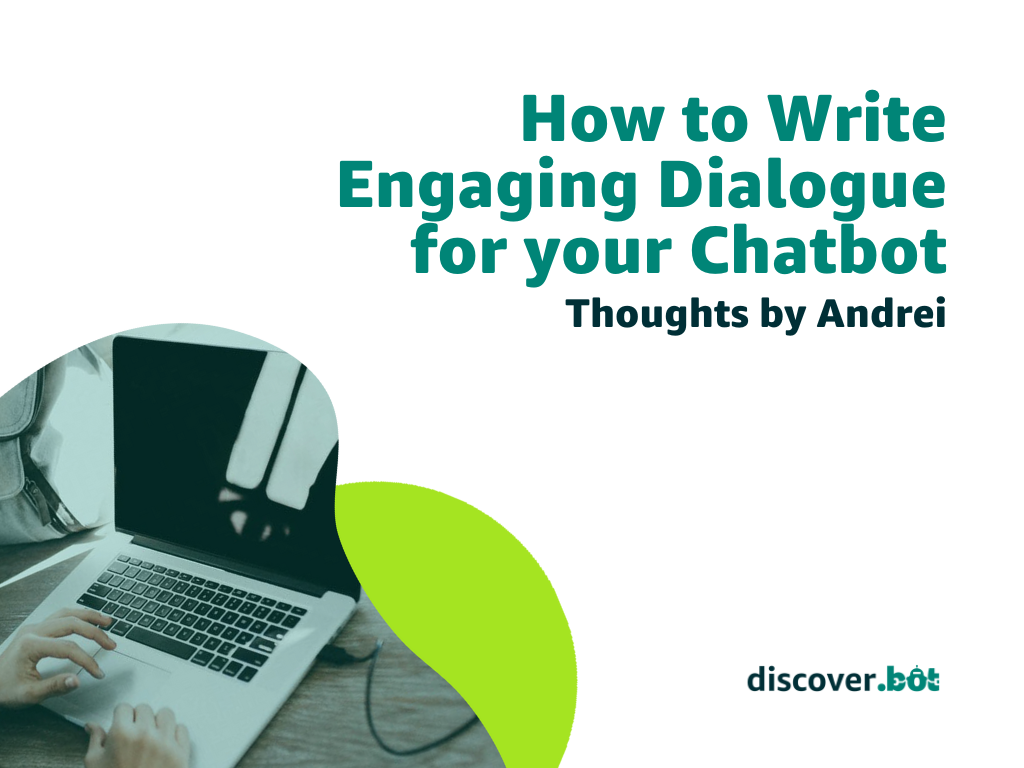
Guest Post: Chat-Writing Tips
How to Write Engaging Dialogue for Your Chatbot
By Discover.bot
Whenever we communicate, we’re expressing a need, thought, or sentiment. When we use language to convey those ideas, we’re engaging in conversation. And the foundation of a meaningful conversation is meaningful dialogue.
This is just as true with chatbots as it is with humans. After all, every chatbot developer knows what happens when a bot fails to engage users through conversation—those users abandon the bot and go elsewhere for the information or experience they’re seeking. The good news? There are specific steps you can take and guidelines you can follow to help you get it right.
If you’re struggling to figure out how to write dialogue for your chatbot, follow the below tips from NLX partner Discover.bot, a community for insights around bot development, building bot frameworks, and connecting with a community of bot developers and industry experts.
Know your personas—and write for them
When it comes to navigating conversations, this means that your bot could be expected to respond to informal language. Social cues, images, emojis, slang—the more of these that your bot can understand, the better its conversations can be. It’s all about hashing out your user personas and knowing how those personas communicate.
If you’re developing a bot, you’ve probably created one or more personas to represent your users, their goals, and their triggers. A key issue with any persona is what your bot needs to say to meet their needs. One persona will have different concerns from another persona, which is why your chatbot script should include precisely the information that each persona is seeking.
But it’s not just about what you say—it’s also about how you say it. Everything from tone to word choice to capitalization (or lack of it) can have an impact. If you’re agonizing over how to punctuate dialogue for a persona, you’re not being nitpicky—it’s an important problem to solve.
Include all basic dialogue functions
Speaking of fundamental questions, remember to cover the basics in your dialogue. Simple salutations, common courtesies, and straightforward affirmations (such as hi, thanks, help, and OK) may seem like banal bits of chitchat, but they’re also among the most common messages sent to chatbots.
Around 50 percent of all chatbots struggle to respond adequately to these simple messages. Chatbots need predetermined responses to these basic user messages, and each reply needs to fit the context. For instance, a bot that always responds to OK with something positive and self-affirming, like, “I’m glad that makes sense,” might not be effective in situations in which a user isn’t completely satisfied or when a user is responding to instructions.
Emojis are a crucial chatbot dialogue function
In conversations with bots, emojis are just as prevalent—if not more so—as such pleasantries as hello and thanks. According to research performed by Dashbot, the “thumbs up” emoji is one of the single most common messages that users send to bots.
For instance, imagine how a fast-food ordering bot failing to recognize emojis would kill the user experience. In this case, the user would get all the way through the ordering process. They’d get excited about the food they were getting and send the bot an emoji indicating their satisfaction. That’s when the bot would get confused, fail to deliver the order, and inconvenience users rather than satisfy them.
This kind of experience will surely frustrate your users, regardless of what they’re trying to achieve. As you consider how to write dialogue for your personas, pay careful attention to their probable use of emojis as responses, affirmations, or even greetings.
Brevity is your friend
If you summon Alexa and ask her to tell you about today’s weather, any response longer than five seconds might seem too long and complicated. Analytics can show you how long is too long for any given instance by looking at what point users drop off from the interaction and stop engaging with the bot.
The solution, of course, is to just keep the conversation brief. More likely than not, users are engaging your bot to solve a specific problem. The faster your bot helps them solve it, the better. Short, straightforward dialogue can get you there.
It’s tempting to go the other way. When you’re considering how to write a bot—especially a bot that solves a technical problem—it’s easy to fall into the trap of talking to users the way you talk to other developers. But that’s rarely in your users’ best interest.
So keep it simple. Keep it short. Keep it focused. Less dialogue really is more.
Aim for a natural conversation flow
If you forget everything else we’ve covered about personas, basic language, emojis, and brevity, remember this: make your chatbot dialogue natural.
By focusing on a natural flow, you might solve the other problems, too. Naturalness is almost a catch-all solution for writing engaging dialogue.
To do this, it’s essential to anticipate the different ways your audience engages with your bot. Will they give affirmative commands or ask questions? Can you use the same responses for each type of request, or do you need to differentiate responses? And if you’re trying to improve conversational flow for an existing bot, look through the bot’s chat history to get a sense of how your users interact with it.
In the end, your dialogue can and should feel natural, no matter what your bot is helping users to achieve. They’ll leave the interaction feeling like they had a good conversation. And you can bet they’ll be back for another one.
Once your bot is up and running with engaging dialogue, you can keep the conversation flowing by registering a .BOT domain for your chatbot at Get.bot. .BOT is an identity for bots that helps them stand out from the noise, drive engagement with users, and showcase your published bot across multiple channels.